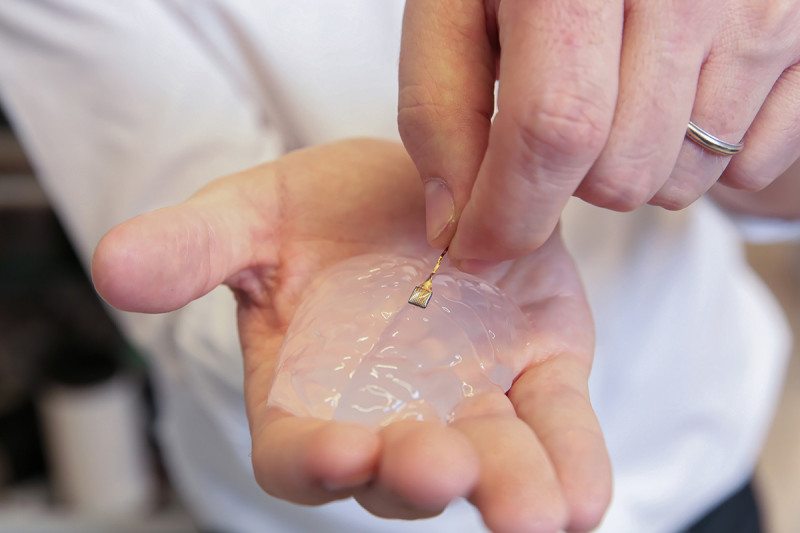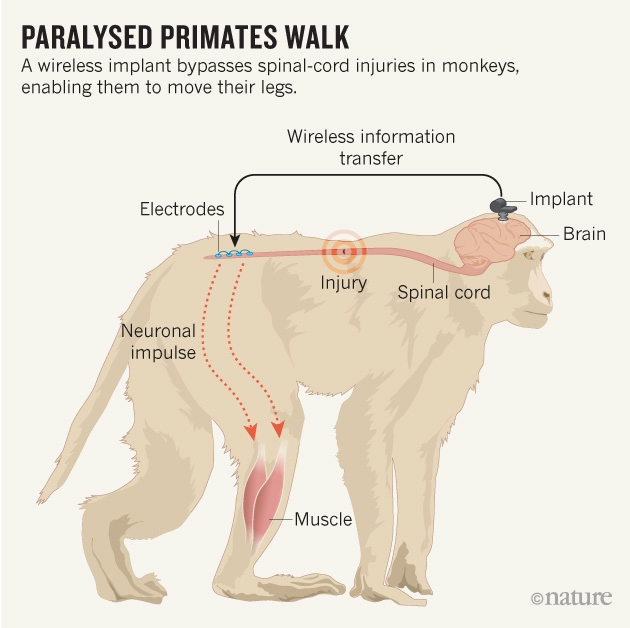Brain implant allowed paralyzed monkeys to walk again

For ten years, neurobiologist Gregor Curtin (Grégoire Courtine) has been exploring the possibility of restoring the motor activity of paralyzed primates with spinal cord injuries. To conduct research, a scientist has to fly regularly from Switzerland to China, where he sets up experiments on primates. The problem is that such studies cannot be conducted in the United States or in Europe - they are prohibited.
This week, the specialist and his team published the results of practical experiments that they had been putting in the laboratory in Beijing all this time. Scientists have developed a wireless implant for the brain, which transmits signals to electrodes implanted in the muscles of the animals' legs. As a result, primates with significant damage to the spinal cord were able to walk again.
“This team of scientists has shown that animals are again able to move with normal coordination of movements. This is a great job, ” said Gaurav Sharma, a neuroscientist who works with paralyzed patients, restoring the motor function of the hands.
')
After the revision, the technology developed by the Swiss scientist may be able to help people with a damaged spinal cord to walk again or at least make some movements with their legs. Gregor Curtin received the consent of two volunteers to install such a system in their bodies.
“The research is helping to discover new ways of conducting clinical trials and bioelectronic patient treatments that are paralyzed,” says bio-engineer Chad Bouton of the Feinstein Institute, New York. By the way, in April of this year, scientists from the above-mentioned institute installed an implant in a patient with a broken spine. He got the opportunity to move his hand, take it items and play Guitar Hero. Together with the implant, the patient received a sleeve with electrodes. These electrodes send electrical impulses to the patient's arm. The impulses are sent precisely to the muscles that are responsible for the grabbing movements of the fingers and hand.
Swiss scientists have been experimenting with laboratory rats for a long time, then going over to primates. According to Curtin, monkeys show approximately the same reaction to the work of the system developed by scientists as the rats. First, the team studied the movement of electrical signals from the brain to the legs of monkeys, conducting a "mapping" of electrical signals and muscles. They also carefully examined the spinal cord in the lower part of the spine, where almost all the electrical signals from the brain go before they are transmitted to the muscles. And after all this process, scientists have reproduced the transmission of electrical signals from primates with a damaged spinal cord.
Monkeys were implanted into the brain with microelectrodes capable of transmitting electrical signals from the brain to a special system that decrypts data and transmits further. Wirelessly, these signals are transmitted to a device that generates specific electrical signals that are transmitted to the lower limbs of animals. As a result, the animals learned to walk again and moved quite well.
“The whole team screamed for joy when they saw all this,” said the scientist, who saw many cases of unsuccessful restoration of motor functions in primates and humans. So far, the coordination of the lower extremities cannot be called ideal, but the effort applied by animals to the legs corresponds to their weight. In other words, the animal, standing on its paws, does not fall, the limbs do not bend.

Neuroscientists have now achieved significant success in creating bionic prostheses. All this was made possible by the development of modern technology. For example, this year Jodie O'Connell-Ponkos (Jodie O'Connell-Ponkos), who lost her arm nearly 30 years ago, received a prosthesis of a new type that can detect even the weakest signal of nerve endings. The prosthesis can perform almost all movements that the owner was thinking about.
The prosthetic arm of the new type "understands" that this electric signal should use the fingers, and this one - the wrist. As a result, the prosthetic arm works in accordance with the user's thoughts. If he decided to take something in his hand, the prosthesis automatically responds to the signal. If the owner of the prosthesis wanted to fix his hair, the system performs the owner's intention. The Coapt bionic prosthesis acts in sync with the other limb, so that you can perform coordinated actions with your own and artificial hands.
Spinal cord injury is an even more complex problem that scientists have been trying to solve for many years with varying success. As for Curtin and his two volunteers, so far they have not been implanted electrodes into the brain, but have just installed a system that sends signals to the muscles of the legs. Thus, patients can not control their legs, the signals are transmitted by scientists "through the air." Specialists are now working out the correct operation of the device, and later plan to use brain implants for humans.
As mentioned above, conducting experiments for Swiss scientists is complicated by European legislation. So Curtin with the team still has to fly regularly to China to continue the experimental series with primates.
DOI: 10.1038 / nature.2016.20967
Source: https://habr.com/ru/post/399023/
All Articles